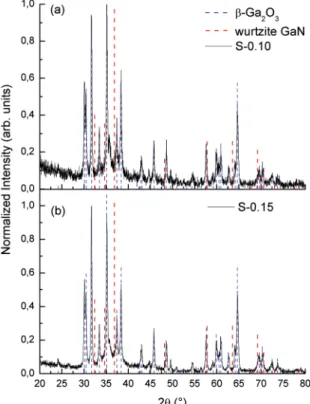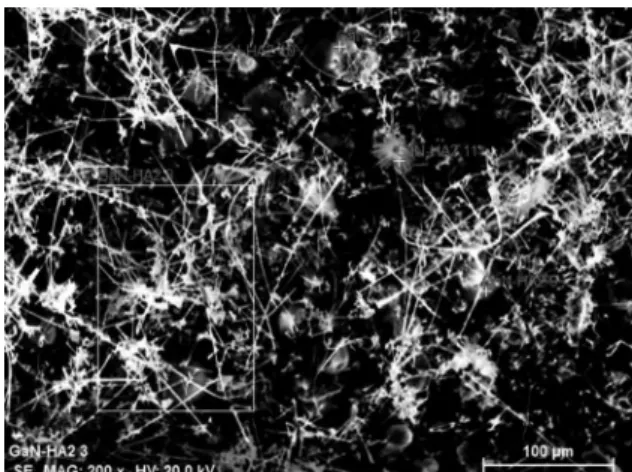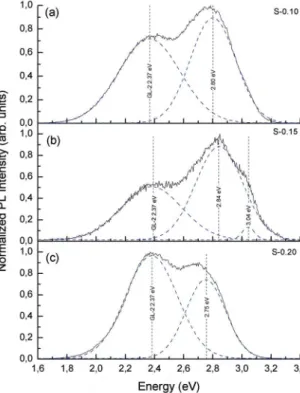Synthesis of Gallium Nitride and Related Oxides Via Ammonobasic Reactive Sublimation
(ARS)
Luis Alberto Hernández-Hernándeza*, Jorge R. Aguilar-Hernándeza, Francisco de Moure-Floresb,
Osvaldo de Melo-Pereirac, Concepción Mejía-Garcíaa, Francisco Cruz-Gandarillaa,
Gerardo Contreras-Puentea
Received: March 22, 2017; Revised: July 07, 2017; Accepted: August 27, 2017
Ammonobasic reactive sublimation (ARS) is proposed as a novel method to synthesize GaN and related oxides. Results indicate that GaN growth occurs by a nitriding process of Ga and related oxides, establishing a direct dependence on NH4OH amount added as a primary chemical reactive. The samples were grown on p-type Si (111) substrates inside a tube furnace, employing GaN powder and NH4OH. The characterizations of the samples were carried out by XRD, SEM, EDS and PL techniques, revealing the inluence of NH4OH on the improvement of GaN synthesis and the enhancement of its optical and structural properties.
Keywords: Gallium nitride, Sublimation, X-ray difraction, Photoluminescence, Gallium oxide
*e-mail: schwarzerengelxv@hotmail.com
1. Introduction
Nitride semiconductors (III-N) properties make them an excellent choice for the development of electronic, optoelectronic and spintronic devices, due to their direct bandgap and high chemical, mechanical and thermal stability1. Nowadays growth technologies to obtain gallium
nitride (GaN) thin ilms are based on epitaxial techniques, like metal-organic chemical vapor deposition (MOCVD) or molecular beam epitaxy (MBE). However, research based on non-epitaxial techniques, like reactive sputtering or ammonothermal reactions have been developed in order to achieve better results for the nitride semiconductor synthesis and enhancement of its properties.
Ammonothermal techniques are similar to our proposed method due to the employing of a furnace and use of ammonobasic compounds as precursors. However, these methods employed polycrystalline GaN as seeds in order to grow the material. Other speciic growth parameters related to this method are, high ammonia (NH3) pressure in the system (between 150-500 MPa), temperature in the range of 500-600 °C and a long growth time that could take several hours2-8. Optimization of the system in order to improve the growth rate and purity are in progress9-11.
Santana et al.12,13 demonstrated that GaN can be grown via the sublimation of GaN powders without any additional source of nitrogen (N), but the results indicate that the samples are nitrogen deicient. Moreover, in that work the growth temperature was limited by the use of a graphite
plate heated by infrared lamps. Taking into account those issues, we propose alternatively, the addition of ammonium hydroxide (NH4OH) as a compensation source of N and the use of a tube furnace for a better control of the temperature needed to synthesize GaN. Ammonium hydroxide has been selected due to its relatively easy handling and low-cost compared to common nitrogen sources of NH3 and N2 that require complementary and complex systems.
The growth of GaN thin ilms by the Ammonobasic Reactive Sublimation (ARS) is reported, this method is proposed as an alternative low-cost route employing a tube furnace. The ARS method is based on a sublimation technique that has high growth rate compared to ammonothermal techniques; it requires a low reactive ambient pressure and few precursors. To our knowledge few groups in the world are processing GaN by sublimation (either close spaced sublimation or closed space vapor transport), which in our case allowed the growth of GaN material, in spite of the fact that these techniques represent a fast non-thermal-equilibrium process, as compared to expensive techniques like MBE or MOCVD. The physical properties of the GaN synthesized by this process are improved by the employment of NH4OH in comparison with previous results12,13.
2. Experimental
Samples were grown on p-type Si (111) substrates, employing GaN powder (99.99% purity) and NH4OH as precursors, all of them contained inside a graphite cell. aEscuela Superior de Física y Matemáticas, Instituto Politécnico Nacional, Ediicio No. 9, U.P.A.L.M.,
San Pedro Zacatenco, C.P. 07738, Ciudad de México, México
bFacultad de Química, Materiales-Energía, Universidad Autónoma de Querétaro, Querétaro C.P.
09790, México
The scheme of the graphite cell is shown in Fig. 1, this is composed by two pieces: 1) a substrate holder and powder container and 2) a cap. Holder and cap are tightly closed in a screw and nut coniguration, these pieces join together to form a semi-hermetic container.
3. Results and Discussion
3.1 Structural, morphology and chemical
analysis
The XRD patterns of the samples, S-0.10 and S-0.15, are shown in Fig. 2 (a) and (b) respectively. For these samples, difraction peaks corresponded to the β-Ga2O3 phase (JCPDS
I
Card No. 041-1103) while for sample S-0.20, the peaks are clearly associated with a mixture of β-Ga2O3 and wurtzite GaN (indexed according to JCPDS Card No. 076-0703), as shown in Fig. 3.
Figure 1. Scheme of the graphite cell. Semi-hermetic container constituted of two pieces: 1) a substrate holder and powder container and 2) a cap.
Ammonium hydroxide was added with an eyedropper and the amount varied in order to evaluate its function as nitrogen compensation source. However, the concentration was not accurately determined due to an apparent GaN permeability property and the high volatility of NH4OH.
Concentrations can be estimated as follows. The holder has a volume of ~0.27 cm3 that can contain a mixture of GaN powder (~150 mg) and NH4OH, close to the substrate surface (< 1 mm). The samples are labeled according to the NH4OH amount employed, considering that each drop has a volume ~0.05 ml, the corresponding labels are presented in Table 1.
Table 1. Label of samples according to the amount of NH4OH.
Sample NH4OH (ml) GaN (mg)
S-0.10 0.10 150
S-0.15 0.15 150
S-0.20 0.20 150
Figure 2. XRD difraction patterns of samples: (a) S-0.10 and (b)
S-0.15. The patterns of both samples are quite similar; however, sample S-0.15 has improved its crystallinity as compare to S-0.10. In sample S-0.15, the background intensity as well as the noise signal decreases.
I ICDD-PDF2 International Center for Difraction Data - Powder Difraction Patterns http://www.icdd.com
II ICSD - Inorganic Crystal Structure Database https://www.iz-karlsruhe.de/en/leistungen/kristallographie/icsd.htm
III Materials Analysis Using Difraction (MAUD) program http://maud.radiographema.com
The material growth was carried out inside a tube furnace, without any vacuum system or gas low. The growth temperature was 1200 °C and the growth time 10 minutes. The growth time is shorter than the growth time employed with other techniques, which were of at least 1 hour14,15.
Structural analysis was carried out by X-ray difraction (XRD) operating in grazing angle with a Cu-Kα radiation source (Bruker D8 advance). Morphology was examined by scanning electron microscopy (SEM, JEOL JSM-6300) equipped with an energy dispersive X-Ray spectrometer (EDS, Bruker XFlash 5010). Photoluminescence (PL) properties at room temperature were measured employing a He:Cd laser (λ=325 nm) as excitation source, a double monochromator (1403-SPEX) and a photomultiplier detector (RCA-C310334).
A Rietveld analysis was performed in order to determine the phase fractions of β-Ga2O3 and GaN present in sample S-0.20. This analysis was carried out by employing the crystallographic information for the compounds GaN (ICSDII
98-002-5676) and β-Ga2O3 (ICSD 98-003-4243) using the MAUD programIII. Results of this study are presented in Table 2.
Figure 3. XRD difraction pattern of sample S-0.20. Contrary to samples S-0.10 and S-0.15, the phase of GaN is completely identiied and indexed; this evidences the inluence of NH4OH as a synthesis
promoter of GaN by the ARS method.
Table 2. GaN and β-Ga2O3 phase fractions in sample S-0.20 according
to Rietveld analysis.
Weight fraction Volume fraction
GaN 0.693 0.665
β-Ga2O3 0.307 0.335
Figure 4. SEM image of sample S-0.10. An irregular morphology is observed, some particles and wire-like structures were grown on the substrate surface.
Figure 5. SEM image of sample S-0.15. The morphology is similar to sample S-0.10; however, the density of wire-like structures in samples S-0.15 is higher than that in S-0.10.
Figure 6. SEM image of sample S-0.20. Morphology of this is completely diferent, the density of wire-like structures appears to be null compared with samples S-0.10 and S-0.15.
grouped by nodes or nucleation points. However, sample S-0.20 (Fig. 6) is completely diferent showing an agglomerate of irregular particles with many porous between them.
The average concentration of gallium and nitrogen according to EDS analysis for each sample are summarized in Table 3. It can be observed that S-0.10 and S-0.15 samples are non-stoichiometric, while S-0.20 sample is almost stoichiometric.
3.2 Photoluminescence
We considered that GaN small crystals act as nucleation centers for β-Ga2O3 structures; then a higher nitrogen concentration provides a higher density of GaN nucleation centers and the growth rate of β-Ga2O3 structures should increase. As we mention before, this sort of gallium oxide structures exhibit blue emission luminescence which is the principal emission in these samples. However, although there are no peaks in XRD patterns related to GaN, there must be some GaN growth on the surface which could be associated with the mentioned GL-2 emission.
The S-0.20 sample presents a very diferent surface morphology; notably there is an apparent absence of wire-like structures. The XRD pattern indicates the presence of polycrystalline GaN and β-Ga2O3. Therefore we assume that
the top layers on the surface correspond to a β-Ga2O3 phase, while the inner layers beneath the surface are GaN. The increase of NH4OH modiies the growth kinetics, implying a diferent surface morphology. The EDS results indicate a higher concentration of nitrogen in this sample, corresponding to XRD results. Additionally, the PL spectrum shows that the GL-2 band has a higher intensity than the band at 2.75 eV, contrary to samples S-0.10 and S-0.15.
Taking into account the previous considerations, we propose a general mechanism of growth for GaN synthesis via NH4OH reactive sublimation. First, the ammonium hydroxide releases hydrogen due to the increase of temperature, the ammonium molecules start to dissociate into diferent complexes as NH3, NH2, NH and N2, N, H2, H14; assuming that there is an increase of the pressure inside of the semi-hermetic graphite cell as the temperature increases. This process will continue until the temperature reaches 1175°C, approximately, when the GaN begin to dissociate, leading to a second increase of the pressure into the chamber related to the release of nitrogen. Under these conditions of temperature and pressure, we assume that the vapor of water can reach a critical point and start to dissociate providing additional H and O. We consider that the efective growth time to be about 10 minutes after the moment when the temperature reaches 1200 °C. At this stage of the growth, Ga vapors are condensed on the Si surface and several reactions could take place, which involves the interactions between the C of the cell, the Si substrate and the Ga ilm already deposited on it, and also with the complexes of nitrogen, hydrogen and oxygen present in the growth cell.
According to our proposed synthesis process and taking into consideration similar reactions to those reported for the GaN synthesis by Nabi et al.15, the reaction stages inside the
cell may be assumed as follows. Since the ainity of Ga and O is greater than that of Ga and N, we propose that after GaN dissociates β-Ga2O3 is synthesized, then this compound react in two ways:
Table 3. Atomic concentration of Ga and N, determined by EDS, in samples S-0.10, S-0.15 and S-0.20
Ga (at. %) N (at. %)
S-0.10 81.46 18.54
S-0.15 67.01 32.99
S-0.20 48.04 51.96
the second is related to β-Ga2O3 nanostructures
17; this means
that a higher concentration of Ga in the samples is related to an increase in β-Ga2O3 phase growth. Additionally, sample S-0.15 shows a low intensity band around 3.04 eV related to the blue shifted emission that is associated with GaN samples contaminated with carbon (C-doped GaN)16.
Figure 7. Normalized PL spectrum (black line) and its related deconvoluted bands (blue dash line) for samples: (a) S-0.10, (b) S-0.15 and (c) S-0.20. PL spectra of S-0.10 and S-0.15 are similar between them, which primary emission is related to β-Ga2O3 nanowires, but
S-0.15 also has a low intensity emission band related to C-doped GaN at 3.04 eV. However, the primary emission band in S-0.15 PL spectrum is the GL-2, contrary to samples S-0.10 and S-0.15.
3.3 Discussion
1a) β-Ga2O3 reacts with C of the cell giving rise to a reaction that provides another kind of gallium oxide (Ga2O) and carbon monoxide (CO):
1b) β-Ga2O3 reacts simultaneously with the ammonia released after the dissociation of the ammonium hydroxide and the C of the cell, giving rise to GaN and CO:
The Ga2O produced during the reaction 1a), could react with the other products released during the previous reactions in diferent ways:
2a) Due to a reduction process
2b) By the reaction with the N present inside the cell
According to the aforementioned reactions, we assumed that the graphite cell also reacts with precursors, in the same way as C reacts in the ammonothermal process. This will reduce the β-Ga2O3 and stimulate GaN synthesis. On other hand NH3 and N are generated by the dissociation of NH4OH and GaN.
The results indicate that sublimation is a viable route in order to synthesized GaN ilms. Our method proposed to use ammonium hydroxide as a nitrogen compensation source in order to achieve better ilms and improve its properties. Contrary to ammonothermal methods that employ GaN seeds to grow the samples, we use silicon (Si) substrates. These ammonothermal methods needs high ammonia pressures (> 100 MPa) while we use only a small amount of ammonium hydroxide (< 0.5 ml). We point out that ammonia is extremely caustic and hazardous compared to ammonium hydroxide; the handling of the reactive precursors and reaction products released during the growth process implies additional systems that increase the cost of the ammonothermal processes, on the other hand, the efective growth time of these methods is longer than 1 hr while the one we propose takes short times, of the order of 10 minutes only.
4. Conclusions
We can conclude that GaN ilm synthesis via ammonobasic reactive sublimation (ARS) is a promising low cost method because it increases the growth rate of polycrystalline GaN by a nitriding process of Ga and its related oxides; it requires the employing of GaN powder and NH4OH as precursors.
It was possible to increase GaN growth while decreasing the β-Ga2O3 fraction with increasing NH4OH concentration in the cell. The method does not require the assistance of conventional nitrogen compensation sources, like N2 and NH3 luxes at high pressure and with long exposure times. Contrary to ammonothermal methods, the ARS method requires only low concentrations of precursors GaN (< 0.200 g) and NH4OH (< 0.5 ml) and short growth times (10 min). The XRD, SEM, EDS and PL measurements evidence the improvement of the optical and structural properties as the concentration of NH4OH increases. Physical properties and growth rates of GaN ilms synthesized by ARS are improved compared with previous results obtained by close space vapor transport12,13. Additionally, an intense white PL emission at
room temperature was observed for all the ilms due to the contributions of the GL-2 band associated with GaN, and the blue band related to the β-Ga2O3 nanostructures.
5. Acknowledgements
This work was supported by CONACyT-SENER [project number 151076]; CeMIE-Sol [project number P37]; and the IPN. [SIP's project number 20160436, 20161872].
We acknowledge to Dr. Ángel Guillén Cervantes from CINVESTAV for his collaboration with the SEM and EDS measurements.
We acknowledge to Dr. Maria de los Ángeles Hernández Pérez from ESIQIE-IPN for his collaboration with the XRD measurements.
We acknowledge to Professor A. D. Compaan from Lucintech Inc. for the fruitful comments on this work.
6. References
1. Pankove JI. GaN: from fundamentals to applications. Materials
Science and Engineering: B. 1999;61-62:305-309.
2. Wang B, Callahan MJ, Rakes KD, Bouthillette LO, Wang SQ, Bliss DF, et al. Ammonothermal growth of GaN crystals in alkaline solutions. Journal of Crystal Growth. 2006;287(2):376-380.
3. Hashimoto T, Wu F, Saito M, Fujito K, Speck JS, Nakamura S. Status and perspectives of the ammonothermal growth of GaN substrates. Journal of Crystal Growth. 2008;310(5):876-880.
4. Ehrentraut D, Kagamitani Y, Fukuda T, Orito F, Kawabata S, Katano K, et al. Reviewing recent developments in the acid ammonothermal crystal growth of gallium nitride. Journal of Crystal Growth. 2008;310(17):3902-3906.
5. Dwilinski R, Doradzinski R, Garczynski J, Sierzputowski L, Kucharski R, Zajac M, et al. Recent achievements in AMMONO-bulk method. Journal of Crystal Growth. 2010;312(18):2499-2502.
6. Yoshikawa A, Ohshima E, Fukuda T, Tsuji H, Oshima K. Crystal growth of GaN by ammonothermal method. Journal of Crystal
Growth. 2004;260(1-2):67-72.
Ga O2 3+2C"Ga O g2 R W+2CO gR W
Ga O2 3+2NH g3R W+3C"2GaN+3CO gR W+3H g2R W
Ga O g2 R W+CO gR W"Ga gR W+Ga lQ V+CO2
7. D'Evelyn MP, Hong HC, Park DS, Lu H, Kaminsky E, Melkote RR, et al. Bulk GaN crystal growth by the high-pressure ammonothermal method. Journal of Crystal Growth. 2007;300(1):11-16.
8. Dwilinski R, Doradzinski R, Garczynski J, Sierzputowski LP, Puchalski A, Kanbara Y, et al. Bulk ammonothermal GaN.
Journal of Crystal Growth. 2009;311(10):3015-3018.
9. Pimputkar S, Speck JS, Nakamura S. Basic ammonothermal GaN growth in molybdenum capsules. Journal of Crystal
Growth. 2016;456:15-20.
10. Malkowski TF, Pimputkar S, Speck JS, DenBaars SP, Nakamura S. Acidic ammonothermal growth of gallium nitride in a liner-free molybdenum alloy autoclave. Journal of Crystal Growth. 2016;456:21-26.
11. Pimputkar S, Kawabata S, Speck JS, Nakamura S. Improved growth rates and purity of basic ammonothermal GaN. Journal of Crystal Growth. 2014;403:7-17.
12. Santana-Rodríguez G, de Melo O, Aguilar-Hernández J, Mendoza-Pérez R, Monroy BM, Escamilla-Esquivel A, et al. Photoluminescence Study of Gallium Nitride Thin Films
Obtained by Infrared Close Space Vapor Transport. Materials
(Basel). 2013;6(3):1050-1060.
13. Santana-Rodríguez G, de Melo O, Aguilar-Hernández J, Mendoza-Pérez R, Monroy BM, Escamilla-Esquivel A, et al. Close space vapor transport of gallium nitride in vacuum.
Materials Letters. 2013;96:34-37.
14. Nabi G, Cao C, Hussain S, Khan WS, Mehmood T, Usman Z, et al. Photoluminescence and hydrogen storage properties of gallium nitride hexagonal micro-bricks. Materials Letters. 2012;79:212-215.
15. Nabi G, Cao C, Khan WS, Hussain S, Usman Z, Safdar M, et al. Synthesis, characterization, growth mechanism, photoluminescence and ield emission properties of novel dandelion-like gallium nitride. Applied Surface Science. 2011;257(23):10289-10293.
16. Reshchikov MA, Morkoç H. Luminescence properties of defects in GaN. Journal of Applied Physics. 2005;97(6):06131.


